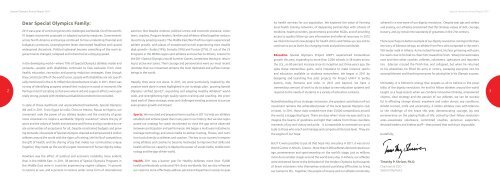2011 Special Olympics
2011 Special Olympics
2011 Special Olympics
Create successful ePaper yourself
Turn your PDF publications into a flip-book with our unique Google optimized e-Paper software.
2<br />
<strong>Special</strong> <strong>Olympics</strong> Annual Report <strong>2011</strong><br />
Dear <strong>Special</strong> <strong>Olympics</strong> Family:<br />
<strong>2011</strong> was a year of continuing economic challenges worldwide. Six of the world’s<br />
10 largest economies proposed or adopted austerity measures. Governments<br />
across North America and Europe continued to face unrelenting financial and<br />
budgetary pressures. Unemployment levels dominated headlines and caused<br />
widespread discontent. Political upheaval became something of the norm as<br />
governments changed, collapsed and retrenched at a dizzying speed.<br />
In the developing world—where 70% of <strong>Special</strong> <strong>Olympics</strong> athletes reside and<br />
compete—people with disabilities continued to face exclusion from most<br />
health, education, recreation and poverty reduction strategies. Even though<br />
they constitute 20% of the world’s poor, people with disabilities are not specifi-<br />
cally mentioned in the U.N. Millennium Development Goals; in <strong>2011</strong>, there was<br />
no way of identifying progress toward their inclusion in social or economic life.<br />
Perhaps most frustrating is that even where aid and support efforts were gen-<br />
erally strong, people with intellectual disabilities tended to be excluded.<br />
In spite of those significant and unprecedented headwinds, <strong>Special</strong> <strong>Olympics</strong><br />
did well in <strong>2011</strong>. From Egypt to India, China to Mexico, Russia to Nigeria, our<br />
movement rode the power of our athlete leaders and the creativity of grass-<br />
roots volunteers to inspire a worldwide “dignity revolution” where the joy of<br />
sport and the values of health and welcome and fitness and joy combine to cre-<br />
ate communities of acceptance for all. Despite constrained budgets and grow-<br />
ing demands, the people of <strong>Special</strong> <strong>Olympics</strong> cheered and empowered 4 million<br />
athletes around the world with the rigors of training, the thrills of competition,<br />
the gift of health, and the sharing of joy that makes our communities unique.<br />
Together, they made up the world’s largest movement of human dignity today.<br />
Nowhere was the effect of political and economic instability more evident<br />
than in the Middle East. In <strong>2011</strong>, 38 percent of <strong>Special</strong> <strong>Olympics</strong> Programs in<br />
the Middle East were in countries experiencing regime collapse, 14 percent<br />
in nations at war, and 6 percent in nations under some form of international<br />
sanction. But despite violence, political unrest and economic pressure, volunteers,<br />
coaches, Program leaders, families and athletes rallied together and produced<br />
truly amazing results: The Middle East/North Africa region experienced<br />
athlete growth, with places of exceptional turmoil experiencing even double<br />
digit growth—Sudan (19%), Somalia (19%) and Tunisia (27%). 21 out of the 23<br />
Programs in the MENA region sent athletes and coaches to Athens, Greece for<br />
the <strong>2011</strong> <strong>Special</strong> <strong>Olympics</strong> World Summer Games, sometimes leaving or returning<br />
to active war zones. Their courage and perseverance were our most recent<br />
reminder that our movement attracts the most dedicated and selfless human<br />
beings in the world.<br />
Happily, they were not alone. In <strong>2011</strong>, we were particularly inspired by the<br />
creative work done in areas highlighted in our strategic plan: growing <strong>Special</strong><br />
<strong>Olympics</strong> Unified Sports ® , expanding and adapting Healthy Athletes ® worldwide,<br />
and strengthening high quality sports training and coaching. We prioritized<br />
each of these strategic areas and challenged existing practices to pursue<br />
even greater growth and impact:<br />
Sports. We recruited and prepared more coaches in <strong>2011</strong> to help our athletes<br />
establish and achieve goals than in any year in our history. But we also repurposed<br />
our strategy for coach recruitment to close the gap we’ve observed<br />
between participation and performance. We began a multi-year initiative to<br />
leverage technology and social media to deliver training, fitness, and nutrition<br />
tools directly to athletes and coaches. The key to our success in empowering<br />
athletes and coaches to become motivated to improve their skills and<br />
health will be our capacity to deploy the power of social media, mobile technology<br />
and the app-driven world.<br />
Health. <strong>2011</strong> was a banner year for Healthy Athletes; more than 13,000<br />
health professionals conducted 764 clinics worldwide. But we also reframed<br />
our vision to more effectively address persistent disparities in access to qual-<br />
ity health services for our population. We explored the value of forming<br />
local health training networks, of deepening partnerships with schools of<br />
medicine, health providers, governments and other NGOs, and of providing<br />
access to quality follow-up care information and referral resources. In 2012,<br />
we intend to launch new designs for health clinics and follow-up care and to<br />
continue to act as levers for changing minds and policies worldwide.<br />
Education. <strong>Special</strong> <strong>Olympics</strong> Project UNIFY experienced tremendous<br />
growth this year, expanding to more than 2,000 schools in 38 states across<br />
the U.S., an 80 percent increase since its inception just three years ago. De-<br />
spite these tremendous gains, we’re impatient to make inclusive sports<br />
and education available to students everywhere. We began in <strong>2011</strong> by<br />
designing and launching five pilot projects for Project UNIFY in Serbia,<br />
Austria, Italy, Romania and India. In 2012 and beyond, we have a<br />
tremendous amount of work to do to adapt to new education systems and<br />
respond to the needs of students in a variety of education contexts.<br />
Notwithstanding all our strategic innovation, the greatest contribution of our<br />
movement remains the unheralded power of the local <strong>Special</strong> <strong>Olympics</strong> club<br />
or team. In <strong>2011</strong>, those clubs created more than 53,000 competitions around<br />
the world, a staggering figure. There are days when I close my eyes and try to<br />
imagine the beams of goodness and light that radiate from those countless<br />
moments of joy and victory and pride. It is impossible to overstate our grati-<br />
tude to those who coach and manage and compete at the local level. They are<br />
the engine of our hope.<br />
But if it were possible to put all that hope into one place in <strong>2011</strong>, it was at our<br />
World Games in Athens, Greece. More than 6,000 athletes demonstrated courage,<br />
perseverance and sportsmanship on the world’s stage, just as millions<br />
more do on smaller stages around the world every day. In Athens, our athletes<br />
were welcomed home to the birthplace of the modern <strong>Olympics</strong> by thousands<br />
of brave volunteers who themselves endured punishing difficulties to bring<br />
our Games to life. Together, the people of Greece and our athlete community<br />
<strong>Special</strong> <strong>Olympics</strong> Annual Report <strong>2011</strong><br />
ushered in a new wave of our dignity revolution. Despite tear gas and strikes<br />
and anxiety, our athletes proclaimed that the timeless values of skill, courage,<br />
bravery, and joy remain the standards of greatness in the 21st century.<br />
There is perhaps no better example of our dignity revolution coming to life than<br />
the story of Ederson Idrogo, an athlete from Peru who competed in the men’s<br />
100-meter walk in Athens. As he inched forward, his face grimacing with pain,<br />
his coach rose to his feet to cheer him toward his finish. Slowly his teammates<br />
rose and then other coaches, athletes, volunteers, spectators and reporters<br />
too. Ederson crossed the finish line, and collapsed, but when he returned<br />
to his wheelchair, he lifted his arms in victory, sweeping everyone into his<br />
accomplishment and thanking everyone for joining him in his Olympic success.<br />
Ultimately, it is Ederson’s energy that propels us all to believe in the possibility<br />
of the dignity revolution. He and his fellow athletes around the world<br />
taught us a huge lesson: when we combine innovative thinking, empowered<br />
citizens, clear strategy and the passion of our athletes, we can be successful<br />
in effecting change almost anywhere and under almost any conditions.<br />
Amidst turmoil, strife and uncertainty, 4 million athletes rose with Ederson<br />
to the challenge of the brave this year, demonstrating courage, joy and<br />
perseverance on the playing fields of life. Joined by their fellow revolutionaries--passionate<br />
volunteers, committed coaches, generous supporters,<br />
devoted leaders and tireless staff—they proved that nothing is impossible.<br />
Gratefully,<br />
Timothy P. Shriver, Ph.D.<br />
Chairman & CEO<br />
<strong>Special</strong> <strong>Olympics</strong><br />
3

















